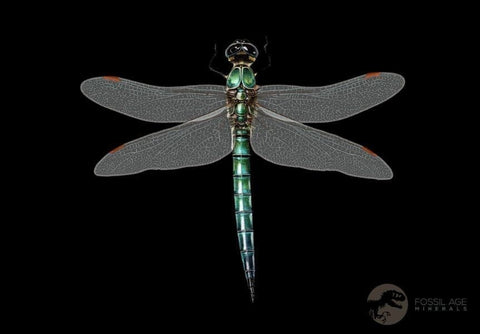0.7" Dragonfly Larvae Fossil Libellula Doris Plate Upper Miocene Piemont Italy Display
Location: Piemonte Area, Santa Vittoria d’Alba. Italy
Weight: 2 Ounces With Display.
Dimensions: 3.3 Inches Long, 2.5 Inches Wide, 1 Inch Thick (Display)
Dimensions: 2.3 Inches Long, 1.2 Inches Wide, 0.2 Inches Thick (Plate)
Insect Dimensions: 0.7 Inches Long, 0.6 Inches Wide
Comes with a Free White Display Box.
Comes with a Certificate of Authenticity.
The item pictured is the one you will receive.
Upper Miocene, 16 Million-Year-old
Fossil Dragonfly Larvae, Libellula Doris
The dealer from whom I acquired this insect plate. He has access to a special shale outcrop in the foothills of the Alps where he quarries them. The thin plate has three complete specimens aesthetically arranged. The detail is excellent, with eye-catching visual appeal. Libellula is a genus of extant dragonflies, commonly called Skimmers. Many of the members of this genus are brightly colored or have banded wings.
Dragonflies belong to the order Odonata, family Libellulidae, because the hindwing is broader than the forewing. It is characterized by large, multifaceted eyes, two pairs of strong transparent wings, and an elongated body. Dragonflies can sometimes be mistaken for damselflies, which are morphologically similar; however, adults can be differentiated by the fact that the wings of most dragonflies are held away from, and perpendicular to, the body when at rest. Dragonflies possess six legs (like any other insect), but most of them cannot walk well. Dragonflies are among the fastest-flying insects in the world.
Dragonflies are important predators that eat mosquitoes and other small insects, such as flies, bees, ants, wasps, and, very rarely, butterflies. They are usually found around marshes, lakes, ponds, streams, and wetlands because their larvae, known as “nymphs”, are aquatic. Some 5680 different species of dragonflies (Odonata) are known in the world today.
Female dragonflies lay their eggs in or near water, often choosing floating or emergent vegetation as deposition sites. In some species, females submerge themselves entirely beneath the surface to attach eggs to submerged plants or other suitable substrates. After a period of incubation, the eggs hatch into aquatic larvae known as naiads.
Dragonflies spend the majority of their lives in this naiad stage, living beneath the water’s surface. These formidable aquatic hunters use extendable jaws to seize prey, feeding on a variety of invertebrates such as mosquito larvae and even small vertebrates, including tadpoles and fish. They breathe through gills located in their rectum and can propel themselves rapidly by expelling water forcefully through the anus—a jet propulsion mechanism. Remarkably, some naiads are even capable of brief terrestrial hunting, a behavior that may have been more common in ancient species when land predators were less developed.
The larval stage of larger dragonflies can last up to five years, while smaller species may complete this stage within two months to three years. When fully mature, the naiad climbs onto a reed or another emergent surface, where exposure to air initiates its final transformation. The exoskeleton splits along a weak line behind the head, allowing the adult dragonfly to emerge. Once free, it expands its wings, hardens its exoskeleton, and takes flight in search of prey such as midges and flies.
Adult dragonflies are highly agile fliers, capable of moving in six directions—upward, downward, forward, backward, and side to side—with remarkable precision. Depending on the species, adults may live for several weeks to as long as five or six months, completing one of the most remarkable metamorphoses in the insect world.


















